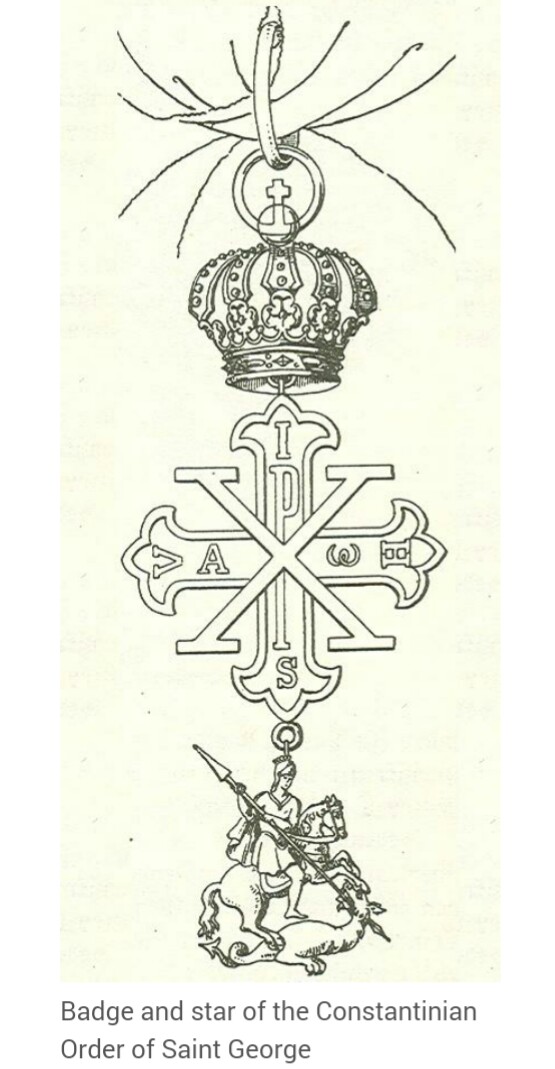http://en.m.wikipedia.org/wiki/Order_of_St._George_(disambiguation)
Order of Sant Jordi d’Alfama
http://en.m.wikipedia.org/wiki/Order_of_Sant_Jordi_d%27Alfama
Knights of St. George (in Catalan, Sant Jordi d’Alfama) appear at different historical periods and in different countries as mutually independent bodies having nothing in common but the veneration of Saint George, the patron saint of knighthood.
St. George of Lydda, a martyr of the persecution of Diocletian in the fourth century, is one of those military saints whom Byzantine iconography represented as a horseman armed cap-à-pie, like the flower of the Roman armies after the military reform of Justinian I in the sixth century. The pilgrim knights of Europe, encountering in the East these representations of St. George, recognized their own accoutrements and at once adopted him as the patron of their noble calling.
This popularity of St. George in the West gave rise to numerous associations both secular and religious. Among secular orders of this name which still exist must be mentioned the English Order of the Garter, which has always had St. George for its patron. The Kingdom of Aragon was placed under his patronage, and in gratitude for his assistance to its armies King Peter II of Aragon founded (1201) the Order of St. George of Alfama in the district of that name. Nevertheless this order received the approbation of the Holy See only in 1363 and had but a brief existence. With the approval of antipope Benedict XIII it was amalgamated with the Aragonese Order of Montesa, and thereafter known as the Order of Montesa and St. George of Alfama.
Order of Saint George
http://en.m.wikipedia.org/wiki/Order_of_Saint_George_(Kingdom_of_Hungary)
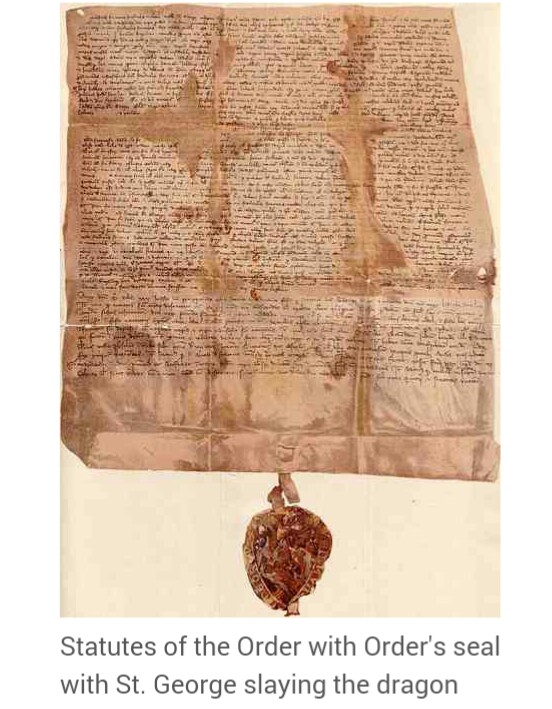
The Order of St George, Hungarian: Szent György Vitézei Lovagrend, was the first secular chivalric order in the world. The Order was founded by King Charles I of Hungary as the Fraternal Society of Knighthood of St George. The precise date of its foundation is not known, but based on the text of its Statutes, it was in existence on St George’s Day, 23 April 1326. The order flourished during Charles’ reign and achieved greater success under the reign of his son Louis I of Hungary. After the death of Louis, the Hungarian throne became the subject of a violent dispute between his relations, and the Hungarian kingdom dissolved into civil war, destroying the original Society. All that is known about the Order in terms of its mission, composition, obligations and activities has been obtained from the only surviving artifact which describes the Society.
Based on the Statutes, although the Society of St George was a political and honorary body, Charles infused the ideals of chivalry into the Society promoting them among the lesser nobles of his kingdom and implementing the classic symbol of chivalry, the knights’ tournament, in Hungarian festivals of chivalry. Unlike the ecclesiastical Orders of the period, members of the Society wore a black, knee-length, hooded mantle, bearing not an heraldic device but an inscription: “IN VERITATE IUSTUS SUM HUIC FRATERNALI SOCIETATE”: “In truth I am just to this fraternal society”.
The Statutes were written in Latin, the language of learned writing in Hungary before the 19th century, and are about 1700 words long, in the form of letters patent. Suspended from the document was the great seal of the Society with the classic iconic representation of St George mounted on a horse slaying the dragon under the horse’s hooves as shown on the right.
Sacred Military Constantinian Order of Saint George
http://en.m.wikipedia.org/wiki/Sacred_Military_Constantinian_Order_of_Saint_George
The Sacred Military Constantinian Order of Saint George is a Roman Catholic order of chivalry. It was fictively established by Constantine the Great, though, in reality, it was founded some time between 1520 and 1545 by two brothers belonging to the Angeli Comneni family. Members of the Angeli Comneni family remained grand masters throughout the sixteenth and seventeenth centuries.
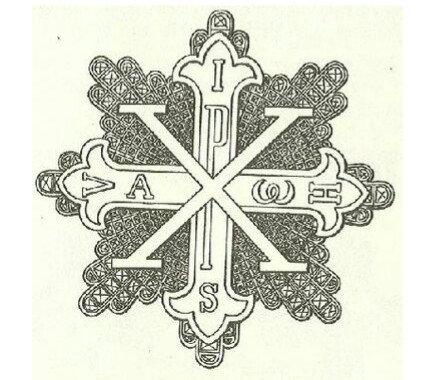
Its incorporation as a religious order of the Roman Catholic Church hereditary in the House of Farnese and its heirs, the Bourbons, dates from the transfer to Francesco Farnese on 11 January 1698, an act confirmed in an imperial diploma, “Agnoscimus et notum facimus”, of the emperor, Leopold I, dated 5 August 1699, and the apostolic brief, “Sincerae Fidei”, issued by Pope Innocent XII on 24 October 1699. These confirmed the succession of the grand magistry to the Farnese family and its heirs as an ecclesiastical office and, crucially, did not tie it to tenure of sovereignty of the Duchy of Parma. Among the first major acts of the Farnese grand magistry were revised, amended and expanded statutes, issued on 25 May 1705 and confirmed in a papal brief dated 12 July 1706; both these confirmed the requirement that the grand magistry should pass by male primogeniture. Following the order’s contribution to Prince Eugene of Savoy’s campaign to drive the Turks from the Balkans between 1716 and 1718, Pope Clement XI, a former cardinal protector of the order, confirmed the order as a religious order of the Roman Catholic Church in the bull, “Militantis Ecclesiae”, of 27 May 1718.
Order of Saint George
http://en.m.wikipedia.org/wiki/Order_of_Saint_George
The Order of Saint George (Russian: Орден «Святого Георгия») is the highest purely military decoration of the Russian Federation. Originally established November 26, 1769 by Empress Catherine the Great it was revived on August 8, 2000 by Decree №1463 of the President of Russia. The award criteria were amended on September 7, 2010 by Presidential Decree 1099.
Order of St. George
http://en.m.wikipedia.org/wiki/Order_of_St._George_(Hanover)
Royal Order of Saint George for the Defense of the Immaculate Conception, http://en.m.wikipedia.org/wiki/Royal_Order_of_Saint_George_for_the_Defense_of_the_Immaculate_Conception
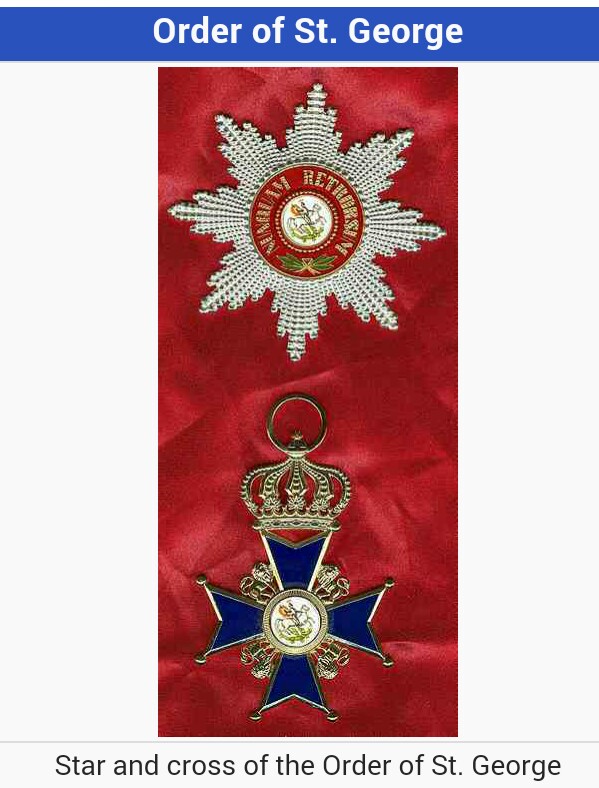
The Royal Military Order of Saint George for the Defense of the Faith and the Immaculate Conception was founded by Maximilian II Emanuel, Elector of Bavaria in 1726 to provide for a means of honouring the nobilityand recognizing distinguished civil and military service. Its status as a Catholic Order was confirmed in a Papal Bull of 15 March 1728 specifically comparing the Order with the Teutonic Order, which had likewise been transformed from a Crusading Order to an exclusive chivalric religious institution for the Nobility.
Ancient Order of St. George
http://en.m.wikipedia.org/wiki/Ancient_Order_of_St._George
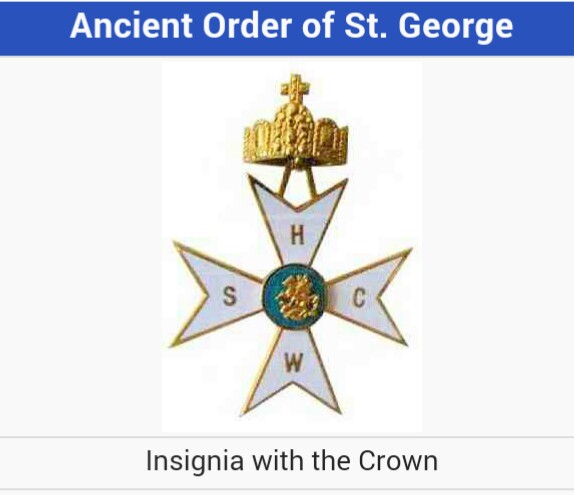
The Ancient Order of St. George (German:Alter Orden vom St. Georg), also known as theOrder of the Four Roman Emperors (German:Orden der Vier Römischen Kaiser) or Order of the Ancient Nobility (German: Orden des Alten Adels), is a historic secular order of chivalry.
The history of the Ancient Order of St. George dates back to the two knightly associations of the House of Luxembourg in the 14th and 15th century, when in 1308 King of Germany (and later Holy Roman Emperor) Henry VII endowed the “Order of the Ancient Nobility” and in 1408 the King of Hungary (and later Holy Roman Emperor) Sigismund instituted the “Order of the Dragon”. Both founders were striving to fortify Christendom and knightly virtues.
As a result of his defeat by the Ottomans at the Battle of Nicopolis in 1396, Sigismund placed the so called “Confraternity With the Dragon” (ref. Ouroboros) of Ancient Nobility under the protection of Saint George, from which the Order still today derives its name of two components.
Following the extinction of the House of Luxembourg in the middle of the 15th century, the Order remained affiliated to the Holy Roman Emperors of the House of Habsburg. Since the 19th century the Order has upheld a firm loyalty to the archducal House of Austria. Accordingly, Dr. Otto von Habsburg-Lothringen was patron of the Ancient Order of St. George from 1972 until his death in July 2011.
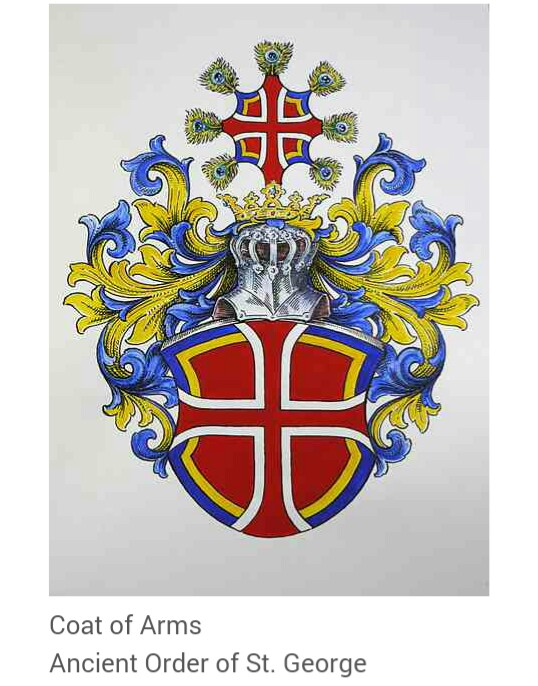
Order of St Michael and St George
http://en.m.wikipedia.org/wiki/Order_of_St_Michael_and_St_George
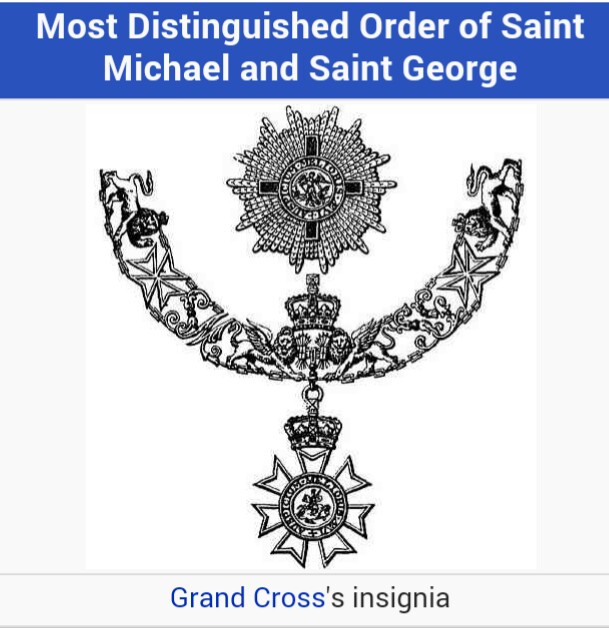
The Most Distinguished Order of Saint Michael and Saint George is a British order of chivalry founded on 28 April 1818 by George, Prince Regent, later King George IV, while he was acting as Prince Regent for his father, King George III.
Order of Saints George and Constantine, an order of the Greek royal family
http://en.m.wikipedia.org/wiki/Order_of_Saints_George_and_Constantine


